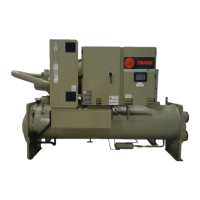32
RTHD-SVX01L-EN
Using untreated or improperly treated water in these units
may result in inefficient operation and possible tube
damage. Consult a qualified water treatment specialist to
determine whether treatment is needed.
Water Pressure Gauges and Thermometers
Install field-supplied thermometers and pressure gauges
(with manifolds, whenever practical) as shown in Figure
13, p. 27. Locate pressure gauges or taps in a straight run
of pipe; avoid placement near elbows, etc. Be sure to install
the gauges at the same elevation on each shell if the shells
have opposite-end water connections.
To read manifolded water pressure gauges, open one valve
and close the other (depending upon the reading desired).
This eliminates errors resulting from differently calibrated
gauges installed at unmatched elevations.
Water Pressure Relief Valves
NOTICE
Evaporator Damage!
Failure to follow instructions below could cause
damage to the evaporator.
To prevent evaporator damage, install pressure relief
valves in the evaporator water system.
Install a water pressure relief valve in one of the condenser
and one of the evaporator water box drain connections or
on the shell side of any shutoff valve. Water vessels with
close-coupled shutoff valves have a high potential for
hydrostatic pressure buildup on a water temperature
increase. Refer to applicable codes for relief valve
installation guidelines.
Water Pressure Relief Valves
NOTICE
Evaporator Damage!
Failure to follow instructions below could cause
damage to the evaporator.
To prevent evaporator damage, install pressure relief
valves in the evaporator water system.
Install a water pressure relief valve in one of the condenser
and one of the evaporator water box drain connections or
on the shell side of any shutoff valve. Water vessels with
close-coupled shutoff valves have a high potential for
hydrostatic pressure buildup on a water temperature
increase. Refer to applicable codes for relief valve
installation guidelines.
Flow Sensing Devices
Note: The installer must provide flow switches or
differential pressure switches with pump interlocks
to sense system water flow. Flow switch locations
are schematically shown in Figure 13, p. 27.
To provide chiller protection, install and wire flow switches
in series with the water pump interlocks, for both chilled
water and condenser water circuits (refer to the Installation
Electrical section). Specific connections and schematic
wiring diagrams are shipped with the unit.
Flow switches must stop or prevent compressor operation
if either system water flow drops off below the required
minimum shown on the pressure drop curves. Follow the
manufacturer’s recommendations for selection and
installation procedures. General guidelines for flow switch
installation are outlined below.
• Mount the switch upright, with a minimum of 5 pipe
diameters straight, horizontal run on each side.
• Do not install close to elbows, orifices or valves.
Note: The arrow on the switch must point in the
direction of the water flow.
• To prevent switch fluttering, remove all air from the
water system.
Note: The Symbio™ 800 provides a 6-second time
delay on the flow switch input before shutting
down the unit on a loss-of-flow diagnostic.
Contact a qualified service organization if
nuisance machine shutdowns persist.
• Adjust the switch to open when water flow falls below
nominal. See “Unit Description,” p. 10, general data
tables for minimum flow recommendations for specific
water pass arrangements. Flow switch contacts are
closed on proof of water flow.
Refrigerant Pressure Relief Valve Venting
WARNING
Confined Space Hazards!
Failure to follow instructions below could result in
death or serious injury.
Do not work in confined spaces where refrigerant or
other hazardous, toxic, or flammable gas may be
leaking. Refrigerant or other gases could displace
available oxygen to breathe, causing possible
asphyxiation or other serious health risks. Some
gases may be flammable and/or explosive. If a leak in
such spaces is detected, evacuate the area
immediately and contact the proper rescue or
response authority.
Note: Vent pipe size must conform to the ANSI/ASHRAE
Standard 15 for vent pipe sizing. All federal, state,
and local codes take precedence over any
suggestions stated in this manual.
All relief valve venting is the responsibility of the installing
contractor.
All RTHD units use evaporator, compressor, and
condenser pressure relief valves (Figure 17, p. 33) that
must be vented to the outside of the building.
Relief valve connection sizes and locations are shown in
the unit submittals. Refer to local codes for relief valve vent
line sizing information.
Installation Mechanical

